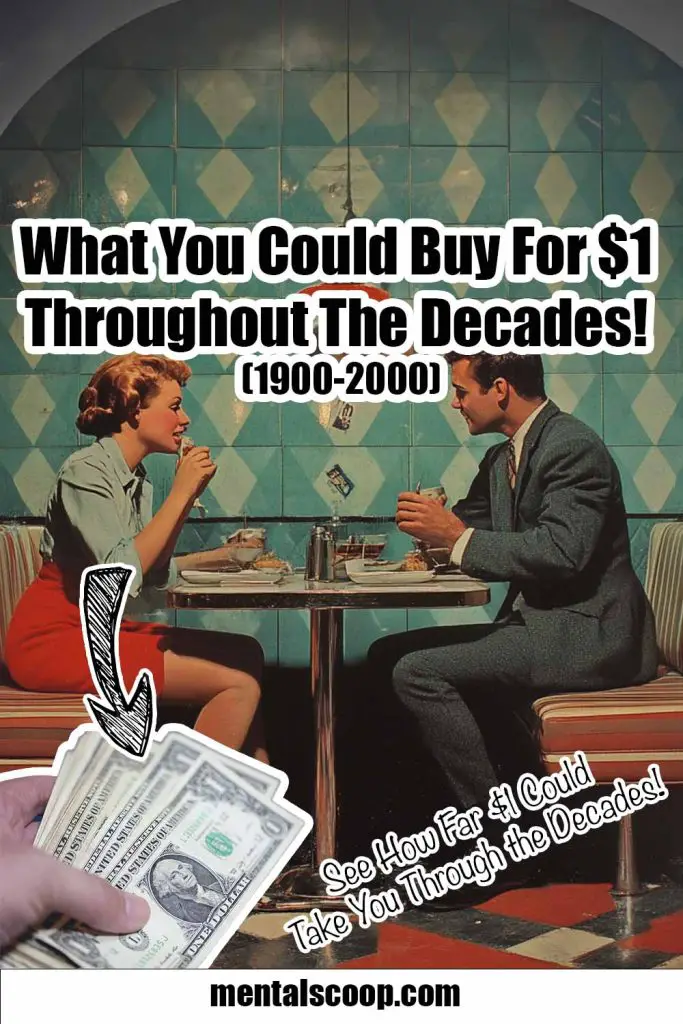What You Could Buy For $1 Throughout The Decades! (1900-2000)

Time has a funny way of making us appreciate the value of money—or at least how far a dollar could stretch. Over the last century, the cost of goods has dramatically shifted due to factors like inflation, economic booms and busts, technological advances, and changing lifestyles.
While a dollar today might barely cover the cost of a coffee, there was a time when $1 could buy so much more. Let’s take a stroll down memory lane to see what $1 could get you in each decade, from 1900 to 2000!
The Early 1900s: A Luxurious Day for a Dollar
In the early 1900s, America was in the midst of the Industrial Revolution. With urban centers growing and new technologies changing daily life, the cost of living was much lower than today. For $1 in 1900, you could fill a day with luxury and still have some change left.
Here’s what $1 could buy in 1900:
- A hearty meal at a nice restaurant for around $0.15
- A brand-new pair of shoes for $0.99
- 10 pounds of sugar or 20 pounds of flour at the local grocery
- A full day’s wage for unskilled laborers (yes, $1 was an entire day’s work for many!)
At this time, $1 could have covered your basic needs and left you with a few extra coins to splurge. Hard to imagine that today, right?
The Roaring 1920s: A Dollar in the Age of Jazz and Prosperity
The 1920s were a time of prosperity, jazz, flapper dresses, and economic growth, known as the Roaring Twenties. With the end of World War I, the economy boomed, and consumerism was on the rise. What could you buy for a dollar during this golden age?
For $1 in the 1920s, you could purchase:
- Admission to the movie theater to see a silent film or even a talkie as they emerged (tickets were about $0.25)
- A fashionable women’s hat, typically sold for $1
- A good-quality men’s dress shirt, which cost roughly $1
- A gallon of milk and a dozen eggs for a combined price of $1
This was a time when $1 could make you feel quite wealthy, with affordable luxury at your fingertips.
The Great Depression Era (1930s): A Dollar’s True Value
The 1930s brought the Great Depression, a time of extreme financial hardship. Unemployment soared, and prices fell as demand for goods plummeted. Despite this, $1 was precious and could stretch further than ever before.
What $1 could get you in the 1930s:
- 25 pounds of flour or enough groceries to feed a small family for several days
- Admission to a double-feature film (two movies for the price of one) and snacks at the concession stand
- A basic toy for a child or a set of marbles
- A one-hour violin lesson from a professional musician (many skilled workers offered their services at lower rates during this period)
While $1 could provide essential goods, the Great Depression made many aware of the fragility of wealth and the importance of every penny.
The Wartime 1940s: Rationing and Resilience
World War II defined the 1940s, bringing about rationing and a focus on the war effort. Even though production boomed to support the war, consumer goods were often scarce. A dollar could still buy quite a bit, though certain products were rationed.
During the 1940s, $1 could buy:
- 16 gallons of gasoline (when not rationed; prices were about $0.15 per gallon)
- A whole paperback book, as paperbacks became widely popularized at around $0.25 to $1 each
- 4 packs of cigarettes, commonly priced at $0.25 a pack
- A movie ticket, soda, and popcorn for an afternoon out (still affordable entertainment at around $0.25 for a ticket)
With ration stamps, a dollar could also help you buy meat, sugar, and other essentials—though you had to be resourceful during wartime.
The 1950s: Post-War Prosperity and the Dollar’s Buying Power
The 1950s ushered in an era of post-war prosperity in America. Suburban life thrived, consumer goods flooded the market, and Americans began to enjoy the comforts of modern living. The value of $1 was strong and could buy many everyday items.
Here’s what $1 could buy you in the 1950s:
- 4 gallons of gas (prices averaged $0.25 per gallon)
- A full meal at a local diner, including pie and coffee
- A brand-new comic book (like the early issues of Superman or Batman) at $0.10 each—meaning you could get 10 for $1!
- Several song records for your home phonograph (45 rpm records cost around $0.50 each)
Americans began to see $1 as a gateway to leisure activities and entertainment, with affordable goods at their fingertips.
The Swinging 1960s: A Dollar in the Age of Change
The 1960s was a decade of cultural revolution, from civil rights movements to the space race, and everything seemed to be changing—including the value of money. Inflation began to creep in, but $1 could still go a long way in many aspects of life.
For $1 in the 1960s, you could purchase:
- A gallon of gasoline, which had climbed to about $0.30 by the late ’60s
- A paperback book for around $0.50, allowing you to pick up two for $1
- A record album on vinyl for $1, giving you a whole collection of music
- A McDonald’s hamburger, fries, and soda (an entire meal for under $1 in the early ’60s!)
Even with rising costs, the value of a dollar allowed Americans to enjoy modern conveniences like never before.
The Disco 1970s: Inflation Begins to Bite
The 1970s was an era of bell-bottoms, disco, and economic turbulence. Inflation soared due to oil crises and stagflation, eroding the purchasing power of $1. However, you could still find bargains and make that dollar work hard.
What could you buy for $1 in the 1970s?
- A gallon of milk, which had risen to around $1
- A single movie ticket to a matinee screening (prices ranged from $1 to $1.50)
- 10 postage stamps (costing about $0.10 each)
- A cheap paperback novel or a used book at a garage sale
Despite inflationary pressures, $1 could still buy everyday essentials, but it was becoming harder to stretch.
The Digital 1980s: The Dollar in the Decade of Excess
The 1980s were marked by technological advancements, the rise of consumer culture, and the first inklings of the digital age. The purchasing power of $1 diminished further as inflation continued to rise, but for thrifty shoppers, bargains were still possible.
In the 1980s, you could buy:
- A slice of pizza or a soft drink, both typically priced around $1
- A pack of trading cards (like Garbage Pail Kids or Topps baseball cards) for $0.50-$1
- A cheap paperback or used book from a discount bin
- A quarter pounder with cheese at McDonald’s (costing about $0.90)
The ‘80s saw the dollar transitioning from buying bulk essentials to being more about small indulgences and bits of entertainment.
The 1990s: The Dollar in the Dawn of the Digital Age
By the time the 1990s rolled around, the world was becoming increasingly digital, and the value of the dollar continued to evolve. Technology, entertainment, and consumer goods dominated the marketplace.
Here’s what $1 could get you in the 1990s:
- A song download from early digital music services
- A candy bar or small snack (prices hovered around $0.75 to $1)
- A one-minute phone call on a payphone (priced around $0.25 per minute)
- A pack of gum, which was a frequent impulse buy for around $1
Although $1 didn’t go as far as in previous decades, it could still get you quick, convenient purchases and entry into the digital world.
The Journey of $1 Through the Century
From the early 1900s, when $1 could practically buy you a whole day of luxury, to the 1990s, when it became a currency for small indulgences, the value of a dollar has had a fascinating journey.
Each decade tells a story not only about the economy but also about the culture and lifestyle of the times. Though $1 may not buy much today, reflecting on its historical value reminds us how far we’ve come and how our relationship with money has evolved.
So, what could $1 buy you today? Perhaps a stroll down memory lane like this one!

More interesting articles you may be interested in reading:

